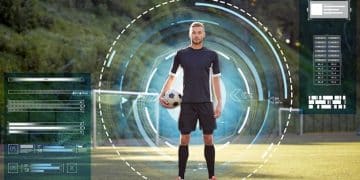How US Soccer Academies Develop Talent with Data Analytics

US Soccer Academies are increasingly using data analytics to identify, develop, and track young talent, optimizing training regimens, and improving player performance, creating a competitive edge.
The landscape of youth soccer development in the United States is undergoing a significant transformation. A key driver of this change is the increasing adoption of data analytics. But, how are US Soccer Academies Using Data Analytics to Develop Young Talent?
By strategically implementing sophisticated tools and methods, academies are gaining deeper insights into player performance, optimizing training programs, and tailoring development plans to unlock each athlete’s maximum potential. This data-driven approach is helping to cultivate the next generation of soccer stars.
How are US Soccer Academies Using Data Analytics to Develop Young Talent?
Data analytics has become an indispensable tool in various sports, offering insights that were previously unattainable through traditional coaching methods. US Soccer Academies are now leveraging the power of data to enhance player development, improve team strategies, and gain a competitive edge. Let’s analyze how they’re doing this.
Tracking Player Performance
One of the primary ways US Soccer Academies are using data analytics is to monitor and assess player performance. This involves collecting data on various metrics, such as:
- Distance covered during matches and training sessions
- Speed and acceleration
- Pass accuracy and completion rates
- Shooting accuracy and efficiency
- Tackling success and defensive contributions
By analyzing this data, coaches can identify areas where players excel and areas that need improvement. This information can then be used to design personalized training programs that target specific skill gaps and enhance overall performance.

Injury Prevention
Another critical application of data analytics in US Soccer Academies is injury prevention. By monitoring players’ physical workloads, fatigue levels, and movement patterns, coaches and trainers can identify potential risk factors for injuries. They can adjust training intensity and volume to prevent overuse injuries.
Data analytics can also help in the rehabilitation process. Analyzing data on players’ recovery progress allows trainers to design tailored rehabilitation programs that expedite recovery and minimize the risk of re-injury. This proactive approach ensures that players spend less time on the sidelines and more time on the field.
In conclusion, data analytics is revolutionizing player performance at US Soccer Academies. By tracking metrics and preventing injuries, data ensures more athletes can reach their full potential, optimizing training and rehab.
Implementing Data Analytics in Training Regimens
The effective implementation of data analytics requires a structured approach that integrates data collection, analysis, and application into training regimens. Here’s how US Soccer Academies are achieving this.
Wearable Technology and GPS Tracking
Wearable technology, such as GPS trackers and smart vests, are commonly used in US Soccer Academies to collect real-time data on players’ movements and physical exertion. These devices track metrics like distance covered, speed, acceleration, heart rate, and more.
Video Analysis and Performance Software
Video analysis software allows coaches to review match footage and training sessions, providing detailed insights into player positioning, tactical execution, and decision-making. By combining video analysis with performance data, coaches can gain a comprehensive understanding of player strengths and weaknesses. This integrated approach enables them to provide targeted feedback and develop strategies for improvement.
- Improved decision-making under pressure
- Enhanced tactical awareness
- Better understanding of team dynamics
Data-Driven Decision-Making
The ultimate goal of implementing data analytics is to make informed decisions that positively impact player development and team performance. Coaches use data to optimize training schedules, adjust tactical strategies, and make informed decisions about player selection and substitutions. This data-driven approach minimizes guesswork and ensures that decisions are based on empirical evidence.

In summary, US Soccer Academies are improving decision-making. GPS tracking, video analysis, and specialized software all play a critical part in this process.
The Role of Data in Talent Identification
Talent identification is a crucial aspect of any successful soccer academy. Data analytics is playing an increasingly important role in helping US Soccer Academies identify promising young players. How are US Soccer Academies Using Data Analytics to Develop Young Talent? They do this by using data to locate athletes with the potential to flourish in a focused training program.
Scouting and Recruitment
Data analytics can be used to scout and recruit players from a wider pool of candidates. By analyzing performance data from youth leagues, tournaments, and scouting events, academies can identify players who possess the attributes and skills necessary to succeed at a higher level. This data-driven approach helps academies cast a wider net and identify hidden gems that might otherwise be overlooked.
Predictive Analytics
Predictive analytics can be used to forecast a player’s potential future performance based on their current skill set, physical attributes, and developmental trajectory. By analyzing historical data on successful players, academies can identify the factors that are most indicative of future success. This information can then be used to assess the potential of young players and make informed decisions about which players to invest in.
Data is essential for identifying the prospects with genuine potential. This creates a more refined and focused pipeline of young talent at US soccer academies.
Challenges and Opportunities in Data Analytics for US Soccer
While data analytics offers numerous benefits for US Soccer Academies, there are also challenges and opportunities to be aware of. Addressing data privacy, staff training, and effective integration are important. As more US Soccer Academies incorporate how are US Soccer Academies Using Data Analytics to Develop Young Talent?, these issues must be carefully addressed.
Data Privacy and Security
One of the primary concerns surrounding the use of data analytics is data privacy and security. Academies must ensure that player data is collected, stored, and used in compliance with all applicable laws and regulations. They must also implement robust security measures to protect against data breaches and unauthorized access.
Staff Training and Expertise
The effective implementation of data analytics requires staff who have the skills and expertise to collect, analyze, and interpret data. US Soccer Academies need to invest in training and development programs to equip their coaches, trainers, and analysts with the necessary skills. They also need to foster a data-driven culture where staff are encouraged to use data to inform their decisions.
- Promoting a data-driven mindset among coaching staff
- Training staff on data interpretation and analysis
- Hiring specialized data analysts.
US Soccer Academies must be aware of data privacy and staff training issues to fully harness the power of information and analytics.
The Future of Data Analytics in US Soccer Academies
The future of data analytics in US Soccer Academies is bright. As technology continues to advance and data becomes more readily available, academies will have even greater opportunities to use data to improve player development and gain a competitive edge. The question of how are US Soccer Academies Using Data Analytics to Develop Young Talent? Will continue to evolve.
Artificial Intelligence and Machine Learning
Artificial intelligence (AI) and machine learning (ML) have the potential to revolutionize data analytics in US Soccer Academies. AI and ML algorithms can automate data analysis, identify patterns and trends that might be missed by human analysts, and provide personalized insights and recommendations for player development.
Enhanced Player Tracking and Monitoring
Advancements in sensor technology and wearable devices will enable even more granular and accurate player tracking and monitoring. This will provide coaches with a deeper understanding of player performance and physical condition, allowing them to make more informed decisions about training and player management.
Data analytics will continue to transform how US Soccer develops new stars and gains a competitive edge.
Case Studies: Successful Implementation of Data Analytics
Several US Soccer Academies have already successfully implemented data analytics programs and are reaping the benefits. Here’s a look at a few case studies.
Example 1: Academy X
Academy X implemented a comprehensive data analytics program that included wearable technology, video analysis, and performance software. As a result, they saw a significant improvement in player performance, reduced injury rates, and increased success in youth tournaments. Moreover, Academy X noted improvement in how are US Soccer Academies Using Data Analytics to Develop Young Talent?.
Example 2: Academy Y
Academy Y used data analytics to identify talented players from underserved communities and provide them with access to high-quality training and development opportunities. This initiative led to the discovery of several promising young players who went on to represent the US in international competitions.
US Soccer Academies are seeing real-world benefits from data collection and analysis. As data analytics continues to evolve, even more academies will benefit from this approach.
| Key Point | Brief Description |
|---|---|
| 📊 Performance Tracking | Monitoring player stats improves training and identifies weaknesses. |
| 🤕 Injury Prevention | Analyzing workloads and fatigue reduces injury risks. |
| 🔎 Talent Identification | Finding promising players through data-driven scouting. |
| 🤖 AI & ML | AI and Machine Learning is optimizing analytics and decision-making. |
Frequently Asked Questions
US Soccer Academies are using data analytics by tracking player performance, preventing injuries, identifying talent, and making data-driven decisions to optimize training and player development.
US Soccer Academies collect data on distance covered, speed, acceleration, pass accuracy, shooting efficiency, tackling success, heart rate, and fatigue levels.
Wearable technology, like GPS trackers and smart vests, provides real-time data on player movements and physical exertion, aiding in performance tracking and injury prevention as US Soccer Academies use data.
Video analysis helps coaches review match footage, understand player positioning, and assess tactical execution, enhancing decision-making and tactical awareness.
Data privacy is crucial to ensure that player data is collected, stored, and used in compliance with applicable laws, protecting against data breaches and unauthorized access.
Conclusion
In conclusion, US Soccer Academies are leveraging data analytics to enhance player development and gain a competitive edge. How are US Soccer Academies Using Data Analytics to Develop Young Talent? By implementing advanced technologies and structured approaches, academies are optimizing training regimens, and making informed decisions.





